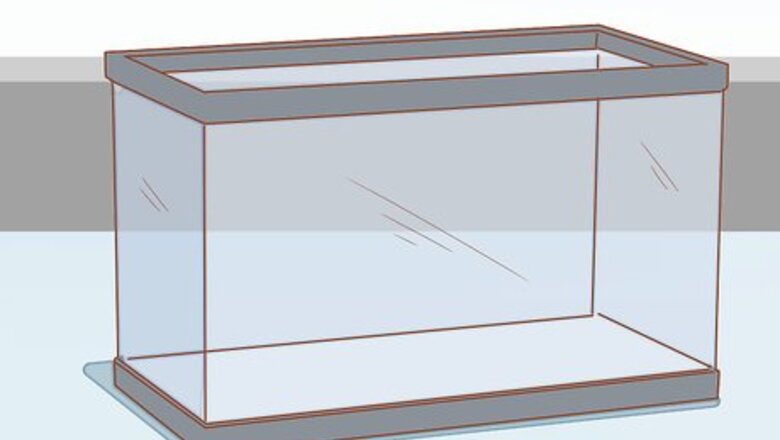
views
Setting Up the Turtle’s Habitat
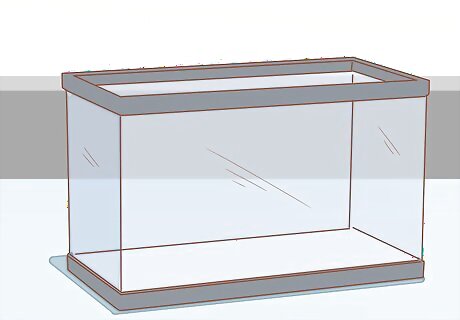
Get a large aquarium. You’ll want a rectangular or square glass aquarium that is the right sized for your turtle when full grown, which will mean plenty of room for swimming, as well as space for a rock or shelf where the turtle can get all the way out of the water. The bigger the tank the better, but be sure to meet the minimum size requirements: 30 gallons minimum for turtles between 4 and 6 inches in length 55 gallons for turtles between 6 and 8 inches 75-125 gallons for adults over 8 inches Minimum length: 3-4 times the length of the turtle Minimum width: 2 times the turtle’s length Minimum height: 1.5-2 times the length of the turtle, plus 8-12 inches above the highest spot it can reach in the tank
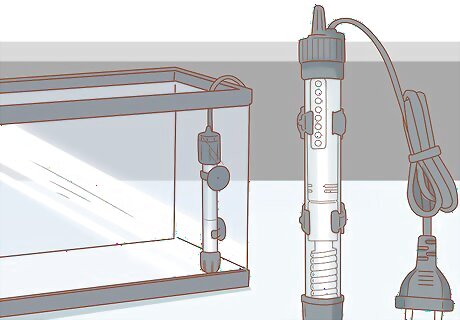
Place a water heater in the tank. Turtle’s cannot regulate their own body temperature, so you will need to keep their water at the appropriate temperature for them by installing a water heater. Most baby turtles will need water between 78° and 82° F, though you should check here to find the care sheet for your turtle type. Make sure the heater covering is plastic or metal, not glass, which turtles may break. Consider using two heaters to heat the water more uniformly and in case one malfunctions. Check the water temperature regularly with a thermometer. Be sure the heater is powerful enough: 75 watts for a 20 gallon tank 150 watts for 40 gallons 250 watts for 65 gallons 300 watts for 75 gallons.
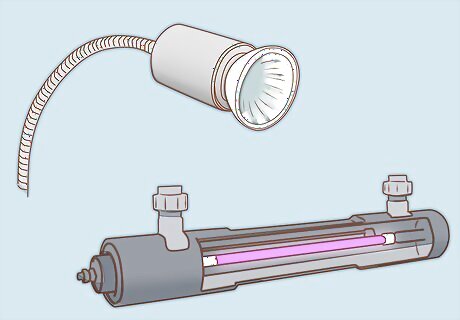
Install a UVB light and a basking light. Turtle’s need UVB light to synthesize vitamin D. It will also help them develop their shells. Without UVB light, they can get MBD (Metabolic Bone Disease.) They need basking lights for warmth because they are cold blooded, meaning they cannot regulate their own temperature. You will need to install artificial lights to provide UVB (ultraviolet light B) as well as warmth. UVB Lamps – Come in compact and tubular. Use the 2.5% or 5% UVB lamp – aka Tropical UVB or Swamp UVB lamps. Desert lamps are too powerful. Place the lamp 12 inches from the water for a 2.5% lamp and 18 inches for a 5% lamp. Basking light – These are normal incandescent or halogen bulbs. The type of lamp does not matter so much as making sure it is the right distance to heat the basking area properly. For baby turtles, the center of the basking area should be close to 95° F, with the edges cooler. Use a thermometer to be sure the temperature is correct. Timer – You will need to turn off the lights 12 hours a day to mimic the natural cycle of light and day. Consider getting a light timer to do this for you. WARNING: Never look directly into the turtle light, as this can damage your eyes. Place it at an angle such that the bulb is not visible to people sitting in the room.
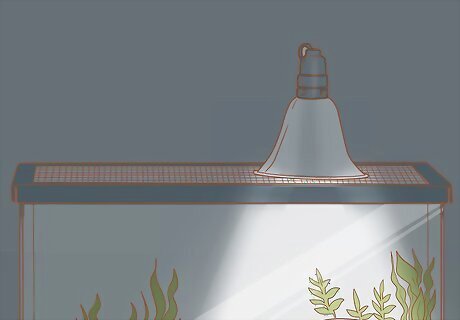
Place a metal screen over the top of the tank. The screen will protect your turtles from things falling into the tank. It is very important, since UVB bulbs will sometimes explode, particularly if splashed with water, and the glass can hurt your turtle. Make sure the screen is metal, since UVB light cannot penetrate glass or plastic.
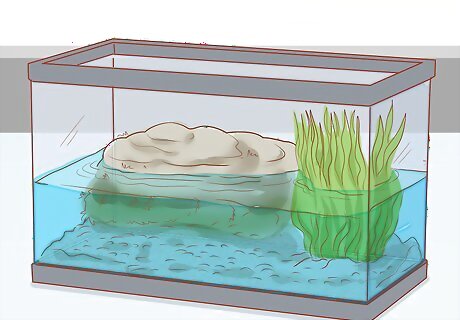
Provide a land area where your turtle can get completely out of the water. This can be a log, rock, or floating turtle dock. Make sure there is a slope so your turtle can crawl out of the water onto it, and make sure it is big enough: The land area should take up about 25% of the surface area of the tank. It should be 1.5 times the length of the turtle and it should be solid enough to not to break. The top of the tank should be 10-12 inches above the land to prevent your turtle from escaping.
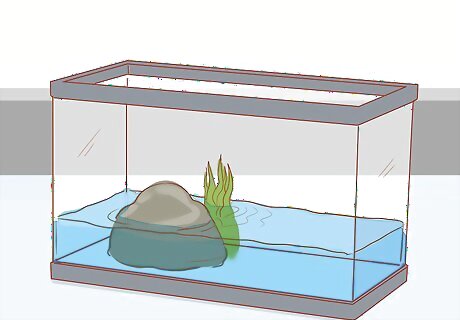
Keep the water the right depth. For baby turtles, the water in the tank should be at least one inch deeper than the width of your turtle’s shell. This will allow them to swim freely. As your turtle grows, you can provide deeper water.
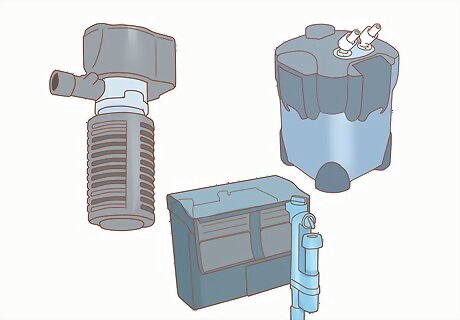
Use a filter to reduce how often you need to change the water. Turtles are messier than fish; they pee and poop a lot. Without a water filter, you’ll need to change your turtle’s water daily to avoid disease. With a filter, you’ll still need to change some of the water every 2-5 days and replace all the water every 10-14 days. There are special turtle tank filters, but you can also use a fish tank filter so long as you make sure to get one that is rated for 3 to 4 times the volume of your tank. Otherwise, it won’t be able to keep up with your turtle’s mess. There are several types of filter: An internal aquarium filter – These filters, which usually attach to the side of the tank via suction cups, are too small to be the primary filter for tanks over 20 gallons. However, you can use them in larger tanks to help circulate the water. A canister filter – The best filters for turtle tanks, they usually mount under the tank and provide great filtration, often using an ultraviolet light sterilizer to kill bacteria and algae. Again, you’ll want to get one rated for 3 to 4 times the volume of your tank. Check here for a review of the most common filters. Hang-on-back (HOB) filters – These filters are designed to be set close to the water in a fish tank. Because water is lower in a turtle tank than a fish tank, you will need a filter cutout – i.e. a place where the glass is cut lower than the rest of the top of the tank – for these filters to function properly in a turtle tank. Again, you’ll need one rated for 3 to 4 times the volume of your tank. Under gravel filters (UGFs) – Reverse flow UGFs pump water up through the gravel at the bottom of the tank, allowing bacteria in the gravel to help filter it. For maximum effectiveness, they should be used with a gravel substrate of 2 inches of rounded pea gravel. Unfortunately, they will not filter large food particles, meaning these must be netted out regularly, and cleaning them is more difficult since they are under the gravel.
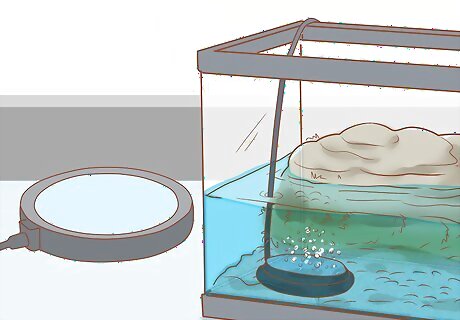
Aerate the water with an air pump or air stone. Keeping your water oxygenated will discourage the growth of the anaerobic bacteria that make the tank dirty and endanger your little turtle’s health.
Adding Plants to the Habitat
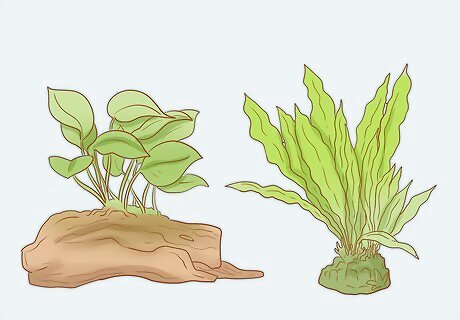
Consider using artificial plants. While plants do provide some benefits like removing nitrates from the water, they are mostly decorative. With artificial plants, you will not have to worry about your turtle eating them or the plant dying.
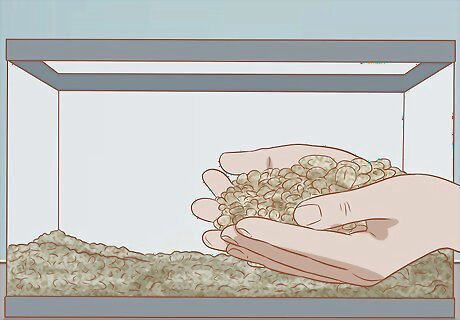
Include a substrate if you are going to have live plants. The substrate is the sand, gravel, or soil that covers the bottom of the tank. It is not necessary, and indeed will make cleaning the tank much harder. A simple painted bottom will do. However, if you are going to add rooted plants or want a more natural look, consider these substrates: Fine sand – Use fine grained sand, like that for children’s sand boxes. It is great for softshell turtles that like to dig in it. However, many turtle owners find it hard to clean. Aquarium gravel – A poor plant substrate, its use is mostly ornamental. Be sure to use gravel that is large enough that your turtle can’t eat it. Fluorite – A porous clay gravel, fluorite is the best choice if you are going to add rooted plants to your tank. It will make the water muddy when you first add it. Several days of filtering should clear the water.
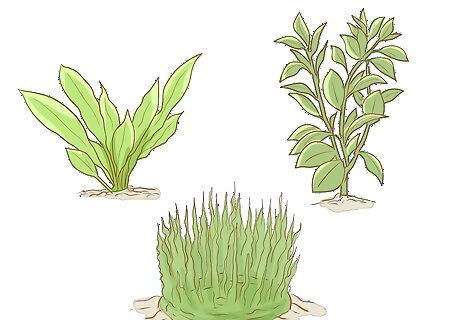
Add plants to the aquarium. Plants are not necessary, but some feel that a more natural environment makes for less stress on your baby turtle. Also, aquatic plants will help keep your tank clean by consuming pollutants and competing for the carbon dioxide that algae needs to grow. Just make sure you pick the right plants to match your turtle species: Anacharis – Grows well in low light and inhibits algae growth. Good for mud/musk turtles. Plant-eating aquatic turtles like sliders, cooters, and painted turtles will destroy it. Java Fern – A hardy, low-light plant with tough leaves that turtles usually will not eat. Java Moss – A hardy, low-light moss that turtles usually don’t eat. Hornwort – A fine-leafed branching plant that grows in floating mats. It tolerates low light and grows quickly enough to survive alongside sliders, cooters, and painted turtles, though they will eat some of it. Red Ludwigia – A tough plant that turtles don’t eat, though they may uproot it from the substrate where it is planted. Requires additional light (2 watts/gallon). Good for small turtles like mud, musk, and painted. Anubias species – They are tough, low-light plants that turtles will not eat. Cryptocoryne species – These plants are low light tolerant and hardy, but must be planted in substrate and do not respond well to uprooting. They work best with smaller turtles in large enclosures. Aponogeton ulvaceus – This plant tolerates low life, is durable, and will not be eaten by turtles. It can grow in plain gravel substrate.
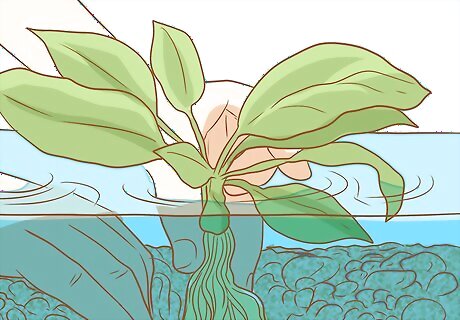
Create a good environment for your plants. Plants need nutrients, light, and (usually) a place to put down roots. To give your plants the best chance to thrive: If you use plants that need a substrate, try one of the clay gravels like laterite or fluorite. They provide plant nutrition with less mess. Add light or choose low-light plants. Most plants need 2-3 watts per gallon of water in the tank, while most aquarium lights provide on 1 watt. You can add more artificial light, but don’t put your turtle tank in a window, as this will overheat the tank and promote algae growth. If your plants do poorly, consider adding an aquatic plant fertilizer, which you can purchase at your pet store.
Feeding Your Baby Turtle
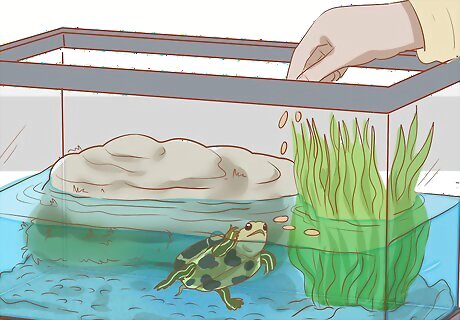
Feed your turtle daily. Baby turtles require lots of food to grow. Give them all the food they want and dispose of leftovers. They also take a lot of time to eat. Give them 30 minutes to several hours.
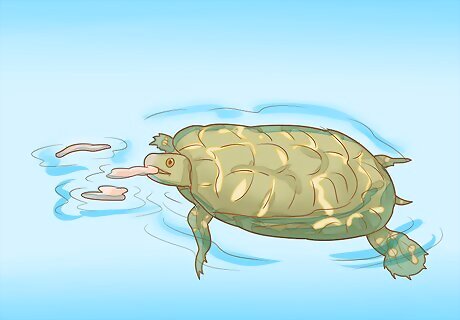
Be sure to put their food in the water. Aquatic turtles must be in water to swallow.
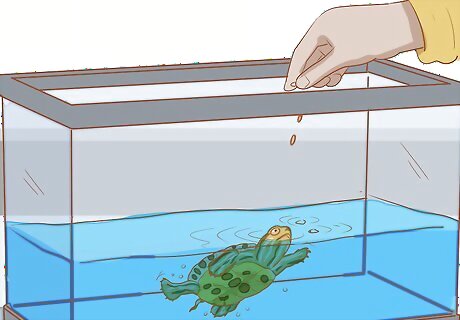
Consider feeding your baby turtle in a separate container of water. This will help keep their tank clean of food debris. If you feed your turtle in its tank, you will need to do your best to scoop out the food debris afterwards. Add just enough water to cover the turtle. Use water from the tank so it is the same temperature and does not shock the turtle. Give them 30 minutes to several hours to eat. Pat the turtle dry when returning it to the main tank in order to remove any food debris.
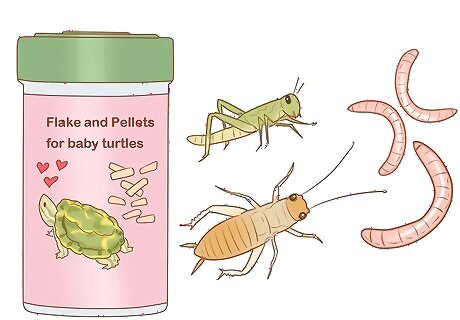
Offer a variety of foods to hatchlings. While turtle food contains all the necessary nutrients for your baby turtles, a well-balanced, varied diet is the best way to ensure your turtles are healthy. In addition, it may be hard to get your hatchling to eat at all, so provide variety until you find something he will eat. Foods appropriate for hatchlings include: Flake and pellet foods – You can find varieties specifically for baby turtles at your pet store. They have all the necessary vitamins and nutrients for your baby turtle. Turtle sticks – Good for baby and adult turtles. Live blackworms, crickets, and mealworms (especially good, as baby turtles are attracted to movement)
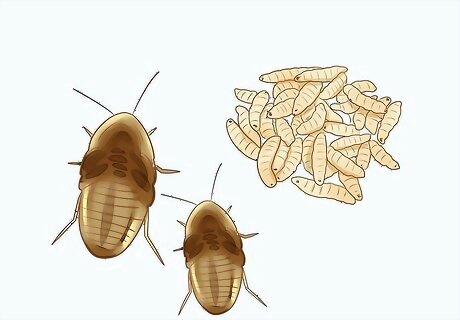
Expand the variety as your baby turtle grows. Once your baby turtle is a few months old, you can expand the variety of his diet. Check here for the appropriate foods for your species of turtle. In addition to the turtle food and live insects above, appropriate foods typically include: Waxworms and small roaches Small fish or shrimp Cooked eggs with shells Fruit (halved grapes, apple, melon, strawberries) Vegetables (kale, spinach, romaine, but no iceberg lettuce or cabbage)
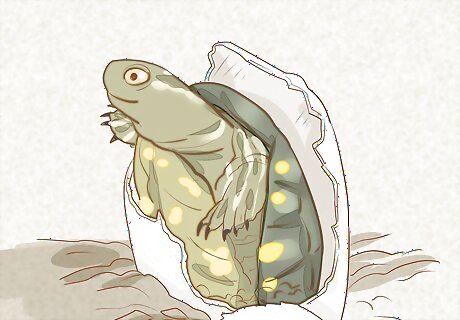
Be aware that newly hatched turtles may not eat for a week or more. They will live off the yolk from their eggs. Offer them food, but do not be overly worried if they do not eat.
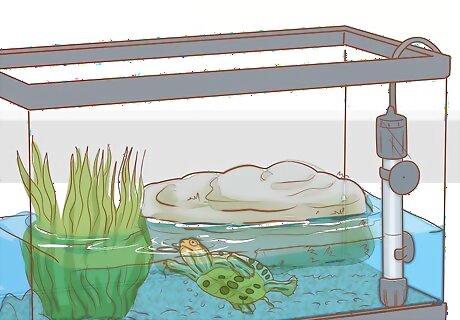
Make sure the water in your tank is warm enough if your turtle is not eating after a few weeks. Turtles will not eat or digest their food if they are too cold. Use a water heater to bring the water to the correct temperature for your turtle.
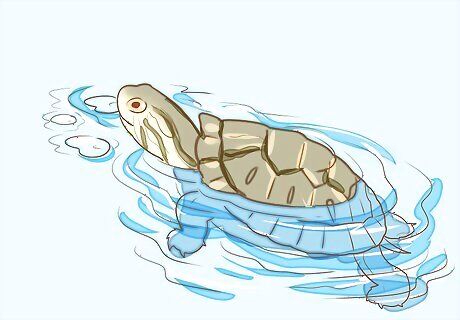
Leave your turtle alone to eat. Many turtle will not eat if watched. If your turtle is not eating, leave it alone with its food.
Keeping Your Turtle’s Tank Clean

Clean as you go. This will make for a healthier environment for your baby turtle and allow you to go longer between big cleans. Aquatic turtles have to eat in the water because they can’t produce saliva. Unfortunately, leftover food quickly decays and makes for a messy tank. Use a net to clean up any leftovers when your turtle is done. Use a siphon-type aquarium vacuum to clean the substrate (i.e. the rocks or gravel at the bottom of the tank) every 4 or 5 days. Use a squeeze-bulb to start the siphon and put the hose end in a bucket below the tank. Gravity keep the water flowing from the tank to the bucket. For added efficiency, you can use your siphoning as a partial water change. Just be sure you siphon off enough water (see below) and replace what you have removed.
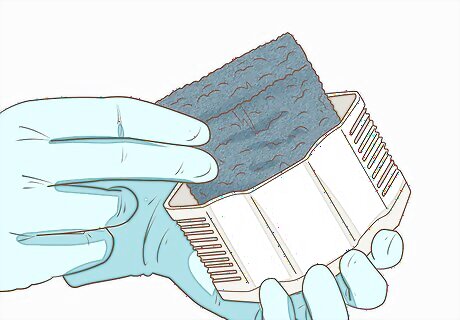
Clean or replace the filter media regularly. The media inside your filter is what strains out dirt, uneaten food, and poop. If it is a sponge, you’ll need to clean it weekly by rinsing it with water. Do not use soap. You can clean foam filters as well, or if you are using filter floss, polyfill stuffing, or charcoal replace it weekly. Filters are full of germs, so be sure to: Unplug your filter before working on it. Work away from food and places where food is prepared. Wear gloves or avoid cleaning your filter when you have cuts or scrapes on your hands. Clean your arms and hands with soap and water after cleaning the filter. Remove and wash any clothes that get splashed with filter water.
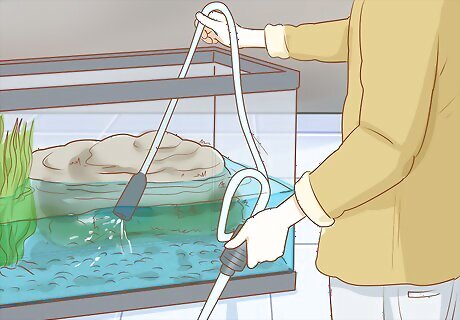
Change the water regularly. Even if you have a filter, you’ll still need to change the water regularly to prevent the build-up of small particles and nitrates. Though you may need to change the water more frequently if you feel it is too dirty, here are some general guidelines: Small Tanks (30 gallons or less) – Change 20% of the water every 2 days. Replace all water every 10-12 days. Medium to Large Tanks (30 gallons or more) – Change 50% of the water every 5 days. Replace all water every 12-14 days. For high quality, high capacity external filters – Change 50% of the water every 7 days. Replace all water every 17-19 days.
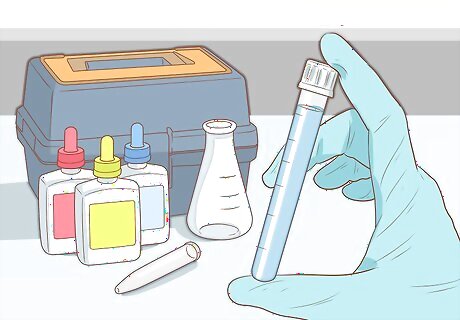
Test your water to make sure you are changing it often enough. Especially in the early days, you’ll want to pay close attention to your turtle’s water to ensure it staying clean. A strong smell or change in water color means a full water change and tank cleaning are needed. The water pH, which measures acidity/alkalinity, should be between 5.5 and 7. Acquire a pH testing kit at your pet store and test your water every 4 days for the first month or so to be sure you are maintaining the proper pH levels.
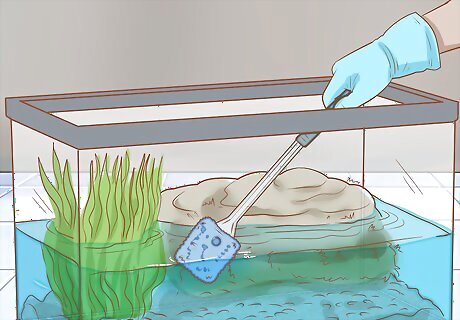
Clean and disinfect the tank when you change out all the water. You can push this to once every 45 days or so, so long as you add solutions that help to disinfect the water and are safe for your turtle (available at most pet stores). Otherwise, you’ll want to disinfect the tank more regularly to keep your turtle healthy. If you have living plants rooted in substrate, you will not be able to do a full cleaning. In this case, you will want to monitor the water quality more closely to be sure your turtle is healthy.
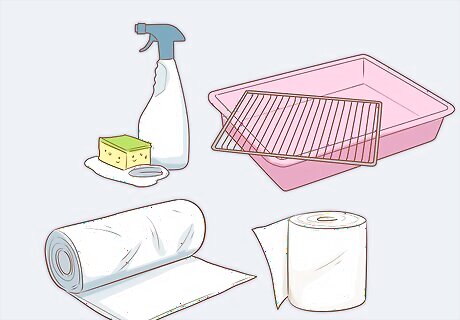
Gather the appropriate supplies for cleaning and disinfecting. You’ll want to set up your cleaning supplies in advance, and do it somewhere away from food preparation areas. Be sure to use a turtle-safe disinfectant from your pet store, or make your own from bleach, using ½ cup bleach to 1 gallon of water. Other supplies include: Sponges Scrapers (like a putty knife) Bowls for soapy water and for rinse water Paper towels Trash bags A spray bottle or bowl of disinfectant solution and a bowl of rinse water. A large receptacle for soaking artificial plants, rocks, and your turtle’s land area
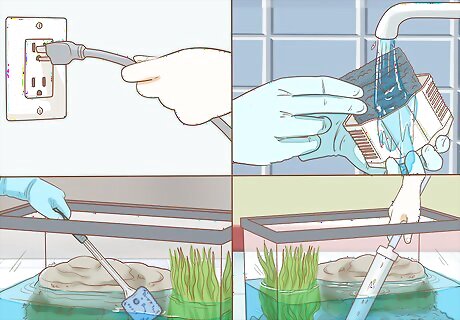
Clean the tank thoroughly. You will first need to remove your turtle and place him in a separate area. A bucket with enough water from his tank to cover him will work fine. You will then need to clean the tank, land area, substrate, and any other surfaces (i.e. the water heater). Use a tub or bathroom sink, not your kitchen sink, to avoid contamination. Unplug and remove all electrical devices: water heater, filter, lamp, etc. Clean the surfaces of underwater electrical devices with soapy water and disinfectant spray. Rinse thoroughly. Remove the land feature. Clean it with soap and water and let it soak in disinfectant for 10 minutes. Rinse thoroughly afterwards. Remove the substrate. Clean it in soapy water and let it soak in disinfectant for 10 minutes. Rinse thoroughly afterwards. Clean the tank with soapy water and a sponge. Fill with disinfectant (1 part bleach to 9 parts water) and let it sit for 10 minutes. Empty and rinse thoroughly. Replace everything in the tank. Make sure the water is at the correct temperature before returning your turtle to his tank. Be sure to wear gloves or to wash your hands thoroughly afterwards to avoid contracting diseases like salmonella.












Comments
0 comment